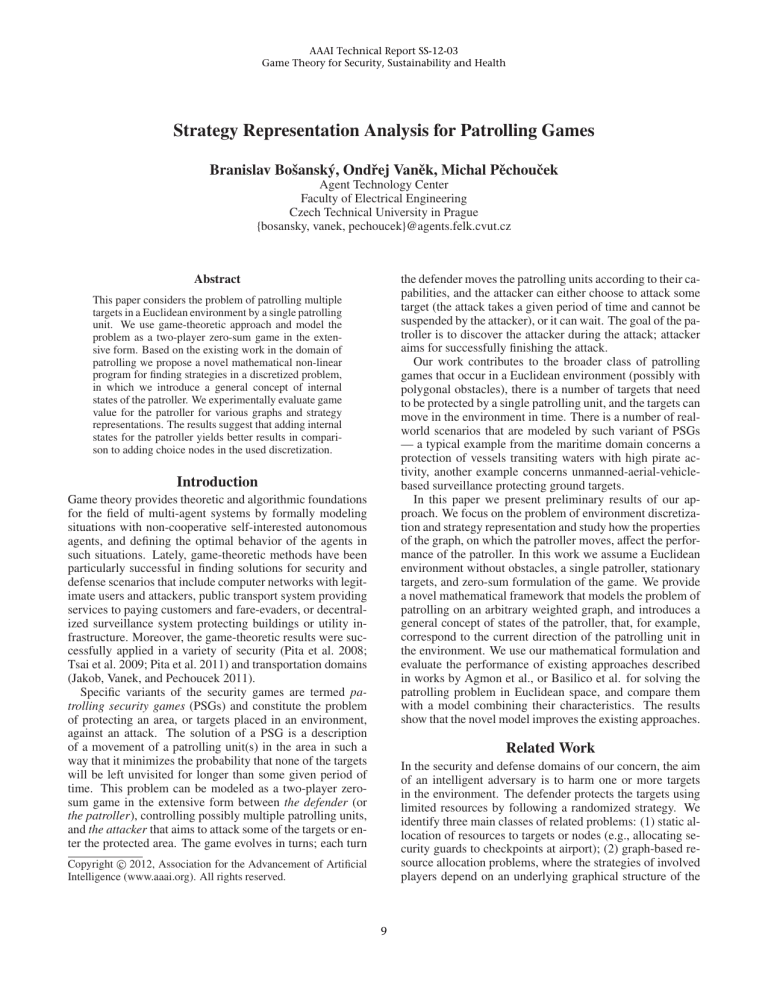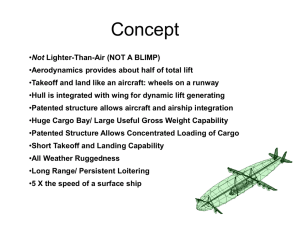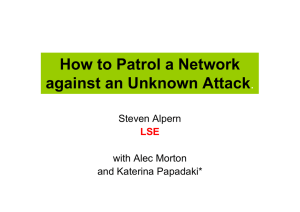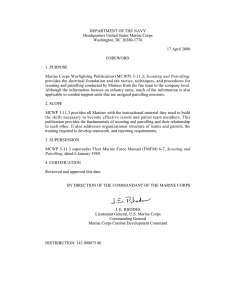Strategy Representation Analysis for Patrolling Games
advertisement

AAAI Technical Report SS-12-03
Game Theory for Security, Sustainability and Health
Strategy Representation Analysis for Patrolling Games
Branislav Bošanský, Ondřej Vaněk, Michal Pěchouček
Agent Technology Center
Faculty of Electrical Engineering
Czech Technical University in Prague
{bosansky, vanek, pechoucek}@agents.felk.cvut.cz
Abstract
the defender moves the patrolling units according to their capabilities, and the attacker can either choose to attack some
target (the attack takes a given period of time and cannot be
suspended by the attacker), or it can wait. The goal of the patroller is to discover the attacker during the attack; attacker
aims for successfully finishing the attack.
Our work contributes to the broader class of patrolling
games that occur in a Euclidean environment (possibly with
polygonal obstacles), there is a number of targets that need
to be protected by a single patrolling unit, and the targets can
move in the environment in time. There is a number of realworld scenarios that are modeled by such variant of PSGs
— a typical example from the maritime domain concerns a
protection of vessels transiting waters with high pirate activity, another example concerns unmanned-aerial-vehiclebased surveillance protecting ground targets.
In this paper we present preliminary results of our approach. We focus on the problem of environment discretization and strategy representation and study how the properties
of the graph, on which the patroller moves, affect the performance of the patroller. In this work we assume a Euclidean
environment without obstacles, a single patroller, stationary
targets, and zero-sum formulation of the game. We provide
a novel mathematical framework that models the problem of
patrolling on an arbitrary weighted graph, and introduces a
general concept of states of the patroller, that, for example,
correspond to the current direction of the patrolling unit in
the environment. We use our mathematical formulation and
evaluate the performance of existing approaches described
in works by Agmon et al., or Basilico et al. for solving the
patrolling problem in Euclidean space, and compare them
with a model combining their characteristics. The results
show that the novel model improves the existing approaches.
This paper considers the problem of patrolling multiple
targets in a Euclidean environment by a single patrolling
unit. We use game-theoretic approach and model the
problem as a two-player zero-sum game in the extensive form. Based on the existing work in the domain of
patrolling we propose a novel mathematical non-linear
program for finding strategies in a discretized problem,
in which we introduce a general concept of internal
states of the patroller. We experimentally evaluate game
value for the patroller for various graphs and strategy
representations. The results suggest that adding internal
states for the patroller yields better results in comparison to adding choice nodes in the used discretization.
Introduction
Game theory provides theoretic and algorithmic foundations
for the field of multi-agent systems by formally modeling
situations with non-cooperative self-interested autonomous
agents, and defining the optimal behavior of the agents in
such situations. Lately, game-theoretic methods have been
particularly successful in finding solutions for security and
defense scenarios that include computer networks with legitimate users and attackers, public transport system providing
services to paying customers and fare-evaders, or decentralized surveillance system protecting buildings or utility infrastructure. Moreover, the game-theoretic results were successfully applied in a variety of security (Pita et al. 2008;
Tsai et al. 2009; Pita et al. 2011) and transportation domains
(Jakob, Vanek, and Pechoucek 2011).
Specific variants of the security games are termed patrolling security games (PSGs) and constitute the problem
of protecting an area, or targets placed in an environment,
against an attack. The solution of a PSG is a description
of a movement of a patrolling unit(s) in the area in such a
way that it minimizes the probability that none of the targets
will be left unvisited for longer than some given period of
time. This problem can be modeled as a two-player zerosum game in the extensive form between the defender (or
the patroller), controlling possibly multiple patrolling units,
and the attacker that aims to attack some of the targets or enter the protected area. The game evolves in turns; each turn
Related Work
In the security and defense domains of our concern, the aim
of an intelligent adversary is to harm one or more targets
in the environment. The defender protects the targets using
limited resources by following a randomized strategy. We
identify three main classes of related problems: (1) static allocation of resources to targets or nodes (e.g., allocating security guards to checkpoints at airport); (2) graph-based resource allocation problems, where the strategies of involved
players depend on an underlying graphical structure of the
Copyright c 2012, Association for the Advancement of Artificial
Intelligence (www.aaai.org). All rights reserved.
9
(a) Euclidean space
(b) Perimeter-like graph
(c) Directly connected targets
(d) Directly connected targets
with additional choice nodes
Figure 1: Visualization of the problem of patrolling in Euclidean space, the patroller is showed as a black circle in the middle
with the arrow representing its direction, large blue circles represent targets; 1b-1d show three possible variants of discretization
of the problem; the numbers represent the weights of the edges measured in number of steps of the patroller.
problem (e.g., placing security checkpoints on a road network); and (3) mobile patrolling in an area and periodic
visiting the targets. All of the security games models assume observability of the defender’s strategy. We follow the
third class and focus on solving the problem of patrolling
modeled by patrolling security games (PSGs). The main
difference between PSGs in comparison to more studied
resource-allocation security games (Kiekintveld et al. 2009;
Yin et al. 2010) is in the extensive form of PSGs – the attacker not only knows the strategy of the defender, but can
also observe its current position.
Existing approaches in patrolling security games are
mostly covered by works of Agmon et al., and Basilico et
al. In (Agmon, Kraus, and Kaminka 2008) the problem of
perimeter patrolling is analyzed. The protected environment
is discretized as a circle graph, where each node is a potential target. The authors seek the defender’s strategy both as a
simple Markovian policy (bidirectional movement), as well
as a policy with an additional state (directional movement
either with or without a cost of changing the direction). The
work was lately improved by concerning complex environmental conditions in (Agmon, Urieli, and Stone 2011).
On the other hand, in (Basilico, Gatti, and Amigoni 2009)
the authors extend the perimeter patrolling to patrolling targets in arbitrary graphs, computing the strategy as a Markovian policy. The work was lately extended by finding abstractions in the graph structure in (Basilico and Gatti 2011).
This work extends existing works by exploring one of
the important aspects of the patrolling games, the impact
of environment discretization and strategy representation on
the performance of the defender, bridging the gap between
target-based patrolling on arbitrary graphs and perimeter patrolling.
ing the target, because the attack takes some time period to
complete (we denote this time as D turns of the game). We
use a zero-sum formulation of the game; hence, the patroller
aims to minimize the probability, that some target will remain unvisited for more than D turns under the assumption
of observability by the attacker. An example of such situation is depicted in Figure 1a. Finding an appropriate representation of the strategies of the patroller and environmental
discretization is essential in solving such patrolling game.
Let us assume we have a discretization of the environment
– i.e., the patroller is moving on some graph G = (N, E).
We assume that every target is placed in some node; hence
Q ⊆ N. Since we do not pose any other assumptions on
the topology of the graph, we define a set of weights W —
w(n1 ,n2 ) ∈ W determines number of turns of the game (steps
of the patroller) it takes for the patroller to reach a node n2
from a node n1 . We assume that the weights are positive,
smaller than D, and they satisfy triangle inequalities.
Besides the positions, we define a set of states S , in which
the patroller can be during the game. These states can represent observable characteristics (e.g., current orientation of
the patrolling robot) or internal beliefs of the patroller. Not
each transition from each node n1 and state s1 to node n2
and state s2 can be meaningful in the scenario; let us use
the example from the perimeter patrolling – if the patroller
is facing one direction and it decides to move forward, it
is not possible that it will reach the following node facing
the opposite direction. Thus, we define T as a set, where
t(n1 ,s1 ),(n2 ,s2 ) ∈ T equals 1 if and only if such transition is between some nodes n1 and n2 , and states s1 and s2 is allowed;
0 otherwise.
Now, we can define variables αh(n1 ,s1 ),(n2 ,s2 ) to be a probability that the patroller will reach node n2 and internal state s2
starting in node n1 and internal state s1 in exactly h turns. Finally, we define an auxiliary binary variable x(n1 ,s1 ),(n2 ,s2 ) that
indicates whether the patroller in its strategy ever uses the
transition (n1 , s1 ) → (n2 , s2 ). Therefore, the optimal strategy α, given the graph G, states S , and transitions T , can
be found by solving the following mixed-integer non-linear
program (MINLP)1 :
Problem Definition and Method
A patrolling game is a two-player game between the defender (also termed the patroller) and the attacker. The
game is played in discrete time in a Euclidean environment
without obstacles, where a set of targets Q is placed. We
seek the strategy for the patroller in a form of randomized
routes through the environment. The strategy of the attacker
is a choice which target to attack and in what situation. We
assume that the attacker can observe the patroller, can select
only one target to attack, and can be captured while attack-
max V
α
s.t.
1
We omit the universal quantifiers for n1 , n2 , s1 , s2 , q, h in the
equations if there are no specific restrictions.
10
0≤
x(n1 ,s1 ),(n2 ,s2 ) ∈ {0, 1}
(1)
αh(n1 ,s1 ),(n2 ,s2 )
(2)
≤1
αh(n1 ,s1 ),(n2 ,s2 ) = 0
w(n ,n )
0 ≤ α(n1 ,s1 1 2),(n2 ,s2 ) ≤ x(n1 ,s1 ),(n2 ,s2 )
w(n ,n )
α(n ,s1 2),(n ,s ) ≤ t(n1 ,s1 ),(n2 ,s2 )
X X 1 w1 (n ,n2 ) 2
α(n1 ,s1 1 i),(ni ,si ) = 1
ni ∈N si ∈S
αh(n1 ,s1 ),(n2 ,s2 ) =
X X
probabilities of reaching the target q from node n1 in at most
D − (w(nk ,n1 ) − 1) = D − w(nk ,n1 ) + 1 steps in optimization constraints (9) as well. Moreover, we need to weight the impact
of this constraint by the variable x that indicates whether the
patroller actually uses the transition (nk , sk ) → (n1 , s1 ).
The MINLP formulation can be approximated as a nonlinear program (NLP) by making the x variables continuous
and modifying the constraints (4) as follows ( denotes some
very small constant, M denotes some large constant):
∀h ∈ {0, . . . , w(n1 ,n2 ) − 1} (3)
w(n ,n )
≤ M · α(n1 ,s1 1 2),(n2 ,s2 )
(4)
(5)
(6)
w(n ,n )
0 ≤x(n1 ,s1 ),(n2 ,s2 ) ≤ 1
max(0,h−w(n ,ni ) )
α(n1 ,s1 1 i),(ni ,si ) · α(ni ,si ),(n2 ,s2 )1
ni ∈N\{n2 } si ∈S
(7)
∀h ∈ {w(n1 ,n2 ) + 1, . . . , D}
D X
X
αh(n1 ,s1 ),(q,sq ) ≥ V
(8)
X
X
h=0
sq ∈S
αh(n1 ,s1 ),(q,sq ) ≥ V·x(nk ,sk ),(n1 ,s1 )
(10)
w(n ,n )
≤x(n1 ,s1 ),(n2 ,s2 ) ≤ M · α(n1 ,s1 1 2),(n2 ,s2 )
(11)
Using multiple states benefits the patroller, since it increases the expressiveness of the representation of patroller’s
strategies. The states can differ in observability from the
attacker’s perspective and the presented NLP can be modified to reflect unobservable states. We introduce variables
y(n1 , s1 ) defined by constraints (12), which represent the
probability that the patroller is in a node n1 and a state s1
based on the transition probabilities α. Now, constraints (8)
can be replaced with constraints (13), where we sum the
probability of reaching the target q over possible starting
states si weighted by the probability of the patroller being in the state si if it is located in node n1 . Similarly,
the constraints (9) are replaced with constraints (14), where
the summation is weighted by the probability that the patroller will reach the node n1 in state si if it is using the edge
nk → n1 (the x variables do not depend on the states here):
h=0 sq ∈S
D−w(nk ,n1 ) +1
w(n ,n )
α(n1 ,s1 1 2),(n2 ,s2 )
w(n ,n )
+ α(n1 ,s1 1 2),(n2 ,s2 )
(9)
∀nk ∈ N, ∀sk ∈ S : t(nk ,sk ),(n1 ,s1 ) > 0
The meaning of the constraints is as follows: constraints (1-2) ensure boundaries for variables α and limit the
auxiliary variables x to binary values; constraints (3) ensure
zero probability for the transition with insufficient time; constraints (4) ensure boundaries for probabilities of using the
transition from (n1 , s1 ) → (n2 , s2 ) (M is some very large
constant); constraints (5) ensure zero probability for not allowed transitions; constraints (6) ensure the summation of
the outgoing probabilities to 1; constraints (7) represent the
recursive definition of probability for higher number of steps
h — the constraints say that the probability of reaching a
node n2 and a state s2 from a (n1 , s1 ) in exactly h steps
can be expressed as a product of probability of transition
to some other node ni (different from node n2 ) and state si ,
and probability of reaching (n2 , s2 ) from (ni , si ) in exactly
(D − w(n1 , ni )) steps.
Constraints (8) represent the first part of optimization constraints – we are maximizing minimal value of V that represent the patroller’s worst-case probability of reaching some
target in at most D steps. Thus, we sum the probabilities
for different number of steps h (note, that α variables represent probabilities of reaching specific node in exactly h
steps). Moreover, since in typical patrolling scenario it is irrelevant in which state we reach the target node q, we sum
through all possible states. These constraints, however, are
not enough for correct functioning of the model. We assume that the edges can be longer than 1 (in the number
of patroller’s steps), therefore we need to give the attacker
an opportunity to start the attack while the patroller is on
an edge. Let’s assume that the patroller is situated in some
node nk and decides to go over an edge to node n1 . After one
step, the patroller is situated somewhere on the edge, and
now the attacker knows the deterministic course of the game
for next (w(nk ,n1 ) − 1) steps. Thus, the attacker can choose
to attack some target q while the patroller is on the edge
(nk , sk ) → (n1 , s1 ). Of all possible places of the patroller on
this edge, starting the attack after one step is a dominating
strategy for the attacker. Therefore, we need to consider the
X
w(n ,n )
X
y(ni ,si ) = 1
ni ∈N,si ∈S
1
α(ni ,si i ),(n
· y(ni ,si ) = y(n1 ,s1 )
1 ,s1 )
(12)
ni ∈N,si ∈S
X
P
si ∈S
D X
X
y(n1 ,si )
·
αh(n1 ,si ),(q,sq ) ≥ V
s0i ∈S y(n1 ,s0i ) h=0 s ∈S
(13)
q
w
X
sk ∈S
(n ,n )
X
α(nk ,sk k 1),(n1 ,si )
y(nk ,sk )
P
·
P
w(nk ,n1 )
s0k ∈S y(nk ,s0k ) s ∈S
s0 ∈S α
i
D−w(nk ,n1 ) +1
·
·
(nk ,sk ),(n1 ,s0i )
i
X
X
h=0
sq ∈S
(14)
αh(n1 ,si ),(q,sq ) ≥ V·x(nk ,•),(n1 ,•)
∀nk ∈ N, ∃sk , si ∈ S : t(nk ,sk ),(n1 ,si ) > 0
Experimental Evaluation
We compared several different graphs and strategy representations for the problem of patrolling of 4 targets depicted in
Figure 1a. More specifically, for fixed position of the targets we measured dependence of the value of the game V
computed by the mathematical program defined in the previous section on varying graphs, on varying number of internal states and allowed transitions T between them, and on
varying duration of the attack D. We used KNITRO solver
at NEOS server (Gropp and More 1997) to solve non-linear
programs, however, due to the non-linearity of the program,
the presented values are only locally optimal.
11
of the patroller in terms of trade-off between performance
and computational costs? (3) How do these characteristics
change if we allow the targets to change their position in
time?
Acknowledgements
The work is supported by the U.S. Army grant no. W911NF11-1-0252, by the Czech Ministry of Education, Youth and
Sports under Research Programme no. LH11051.
References
Agmon, N.; Kraus, S.; and Kaminka, G. A. 2008. Multirobot perimeter patrol in adversarial settings. In ICRA,
2339–2345.
Agmon, N.; Urieli, D.; and Stone, P. 2011. Multiagent
Patrol Generalized to Complex Environmental Conditions.
In AAAI Conf. on Artificial Intelligence, 1090–1095.
Basilico, N., and Gatti, N. 2011. Automated Abstractions
for Patrolling Security Games. In AAAI Conf. on Artificial
Intelligence, 1096–1101.
Basilico, N.; Gatti, N.; and Amigoni, F. 2009. Leaderfollower strategies for robotic patrolling in environments
with arbitrary topologies. In Proc. of the 8th Int. Conf. on
Autonomous Agents and Multiagent Systems, 57–64.
Gropp, W., and More, J. 1997. Optimization Environments
and the NEOS Server. In Buhmann, M. D., and Iserles,
A., eds., Approximation Theory and Optimization, 167–182.
Cambridge University Press.
Jakob, M.; Vanek, O.; and Pechoucek, M. 2011. Using
agents to improve international maritime transport security.
IEEE Intelligent Systems 26(1):90–96.
Kiekintveld, C.; Jain, M.; Tsai, J.; Pita, J.; Ordóñez, F.; and
Tambe, M. 2009. Computing optimal randomized resource
allocations for massive security games. In Proc. of the 8th
Int. Conf. on Autonomous Agents and Multiagent Systems,
689–696.
Pita, J.; Jain, M.; Western, C.; Portway, C.; Tambe, M.; Ordonez, F.; Kraus, S.; and Parachuri, P. 2008. Deployed
ARMOR protection: The application of a game-theoretic
model for security at the Los Angeles International Airport.
In Proc. of the 8th Int. Conf. on Autonomous Agents and
Multiagent Systems.
Pita, J.; Tambe, M.; Kiekintveld, C.; Cullen, S.; and Steigerwald, E. 2011. Guards - game theoretic security allocation
on a national scale. In Proc. of the 10th Int. Conf. on Autonomous Agents and Multiagent Systems.
Tsai, J.; Rathi, S.; Kiekintveld, C.; Ordóñez, F.; and Tambe,
M. 2009. IRIS - A Tool for Strategic Security Allocation
in Transportation Networks Categories and Subject Descriptors. In Proc. of the 8th Int. Conf. on Autonomous Agents and
Multiagent Systems, 37–44.
Yin, Z.; Korzhyk, D.; Kiekintveld, C.; Conitzer, V.; and
Tambe, M. 2010. Stackelberg vs. Nash in security games:
Interchangeability, equivalence, and uniqueness. In Proc.
of the 9th Int. Conf. on Autonomous Agents and Multiagent
Systems, 1139–1146.
Figure 2: Results of five compared models.
We compared five representative models: Perimeter represents a directional model without a cost for turning based
on works by Agmon et al., the graph has 4 nodes corresponding to the targets (as in Figure 1b), and there are two
possible observable states representing the orientation of the
patroller. All remaining models are based on Basilico et al.:
in Direct the graph has 4 nodes, each node is directly connected with the other one (as in Figure 1c), and there is only
one patroller’s state; in Direct7n the graph has 7 nodes (as
in Figure 1d), there is only one patroller’s state; in Direct2s
the graph has 4 nodes, there are two observable patroller’s
states, and there are no restrictions for the patroller in changing its state (in contrast to Perimeter); in Direct2is the states
of the patroller are not observable by the attacker.
The results depicted in Figure 2 suggest that the patroller’s
strategy performs the worst for the Perimeter model, while
it achieves the best values for the Direct2is model. Note,
that modifying the graph by adding nodes can worsen the
performance of the patroller (see the results for the Direct
and Direct7n models). This phenomenon is caused by the
strategy representation, in which the best strategy for the Direct model can be unrepresentable in the Direct7n model.
Conclusions and Future Work
In this paper we present preliminary results of the ongoing
work on the problem of patrolling in a Euclidean environment. We proposed a mathematical framework that combines principles existing in the previous works on patrolling
and we showed how different discretization of Euclidean
space can affect the effectiveness of the patroller. Moreover,
we introduce the general concept of states of the patroller,
that can either be fully observable to the attacker (representing, for example, the current direction of the patroller), or
the attacker can not observe them (representing varying intentions of the patroller). The results suggest that increasing
the expressiveness of patroller’s strategies using the states
gives better results in comparison to adding new nodes.
However, the presented results are preliminary and further
experiments on varying graphs needs to be carried out to
obtain statistically significant results. Moreover, the work
will continue in a number of directions and we will mainly
aim to answer following questions: (1) Is it always better
for the patroller to use shortest paths when moving from one
target to another? (2) What is the optimal number of states
12




